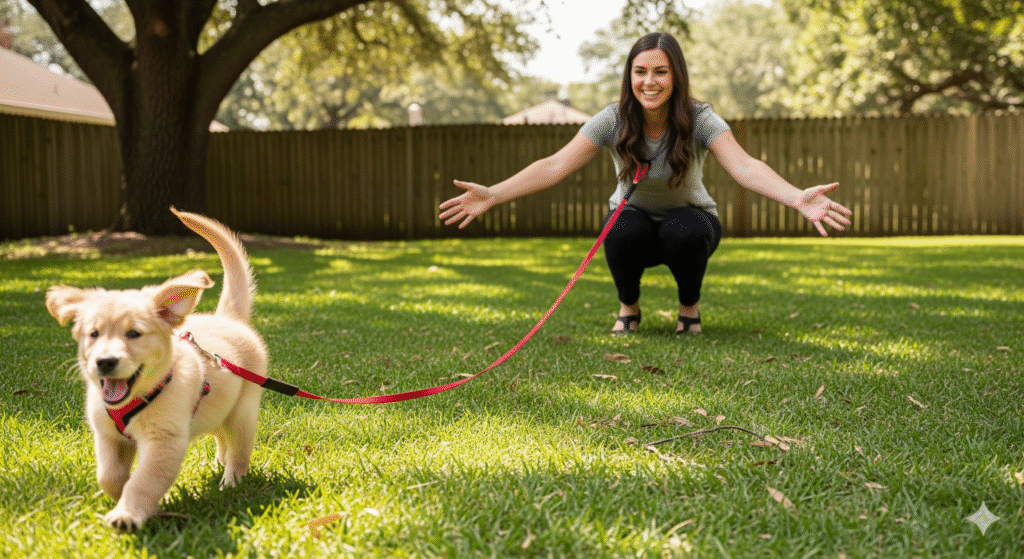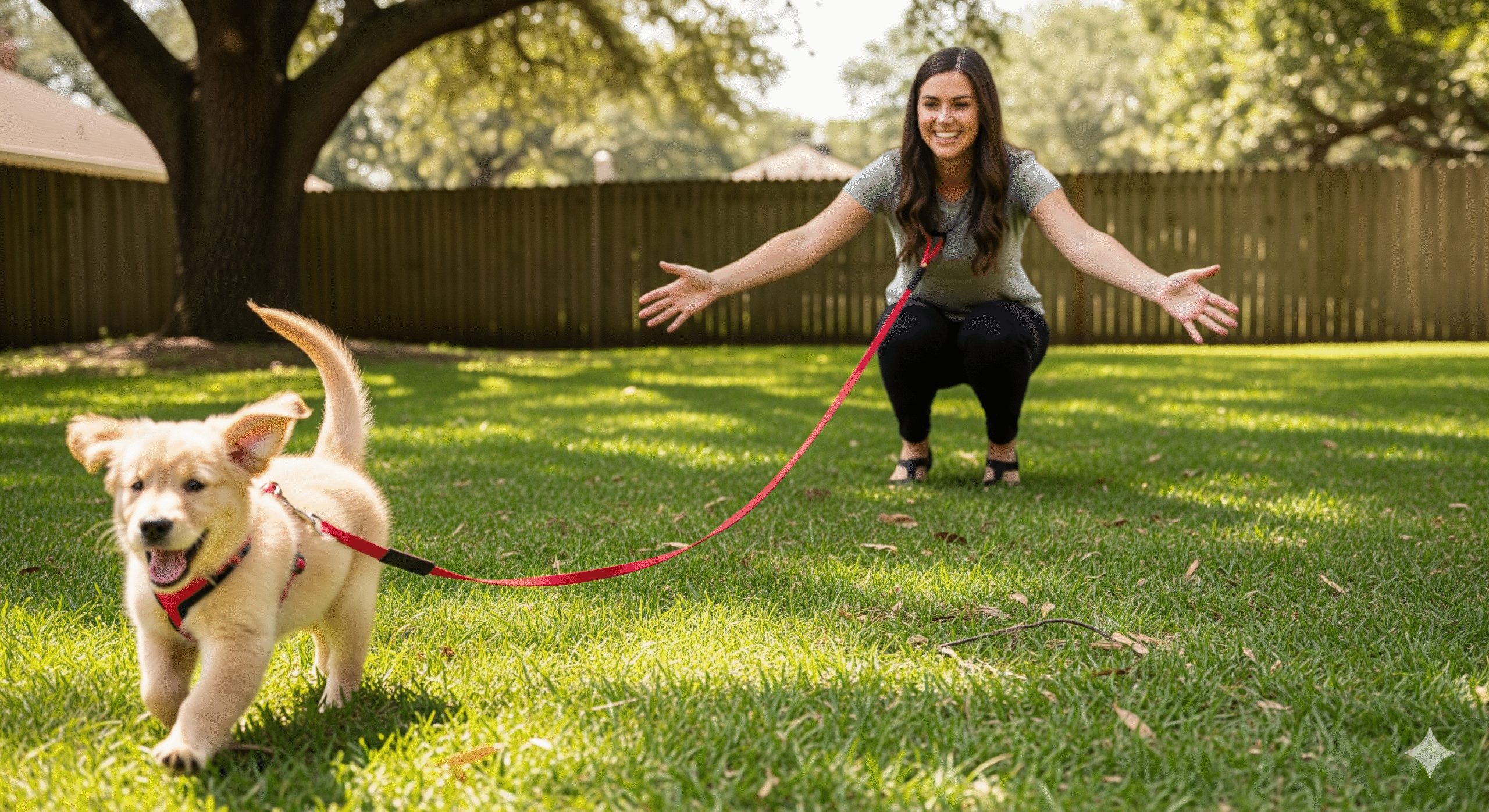The image of your dog running freely through a field, responding instantly to your call, is the dream of many puppy owners. Achieving this level of trust and obedience requires more than just a strong desire; it requires a systematic, safety-first approach to off-leash training. This is not a milestone to rush. Off-leash freedom is a privilege that must be earned through consistent training and proofing, not a right granted by simply removing the leash. Doing it too early or incorrectly can lead to disaster, from a lost puppy to a tragic accident.
This comprehensive guide will walk you through the exact prerequisites, foundational skills, and step-by-step process to build an unshakable off-leash recall. We’ll prioritize safety at every stage, ensuring your puppy’s freedom doesn’t come at the cost of their well-being.
Here’s what we’ll cover:
✔️ The critical prerequisites your puppy must master before you even consider off-leash work
✔️ How to build a powerful recall using high-value rewards and positive reinforcement
✔️ A progressive training plan from long-line to controlled areas to full freedom
✔️ How to proof your commands against real-world distractions
✔️ The most common mistakes that sabotage off-leash training
✔️ Safety equipment that is non-negotiable for training
Let’s build the foundation for a lifetime of safe and joyful off-leash adventures.
When to Start: The Prerequisites Are Everything ⏰
Timing is critical. Starting too early is the number one cause of failure. Your puppy is NOT ready for off-leash work if they do not consistently demonstrate the following:
1. A Rock-Solid Recall On a Long Leash 🎯<
Your puppy must come when called 100% of the time on a 15-30 foot long leash in a mildly distracting environment (like your backyard). If you cannot reliably get their attention on a long line, you have no chance off-leash.
2. Rock-Solid Basic Obedience 🎓
They should respond reliably to:
- Their Name: A head turn and engagement.
- “Sit” and “Stay”: For impulse control.
- “Leave it”: To avoid chasing wildlife or eating dangerous items.
3. A Strong Bond and Desire to Engage With You ❤️
Off-leash reliability is built on the premise that being with you is more rewarding than anything the environment has to offer. If your puppy would rather sniff than play with you, you need to work on your engagement first.
4. Mental Maturity 🧠
Most trainers recommend waiting until a puppy is at least 6-12 months old and has passed through adolescence. Their brain needs to be developed enough to handle impulse control and make good decisions.
Foundational Skill #1: Building an Ironclad Recall 🗣️
The recall (“come”) is the most important command for off-leash safety. It must be heavily rewarded and never punished.
- Use a Unique, High-Value Cue: Use a special word like “Here!” or a whistle. Never use their name for a recall; their name should just mean “look at me.”
- Be the Best Party in Town: When your puppy comes to you, the reward must be amazing. Use real meat (chicken, hot dogs), a favorite toy, and immense praise. Make coming to you the best thing that happens all day.
- Never Punish a Recall: If you call your puppy to you and then scold them for something they did earlier, you are teaching them that coming to you ends the fun. Always make it a positive experience.
Foundational Skill #2: Mastering the Long Line 🪢
A 30-foot biothane long line is your most important training tool. It provides a safety net while giving the illusion of freedom.
- Practice in a Secure Field: Let the line drag behind your puppy.
- Let Them Get Distracted: Allow them to sniff and explore.
- Practice Your Recall: Use your high-value cue. If they don’t respond immediately, you can gently step on the line to prevent them from self-rewarding by ignoring you.
- Reward Heavily: When they come, give them the amazing reward.
The Step-by-Step Off-Leash Training Plan 📝
Phase 1: The “Controlled” Environment (Fenced Area) 🏡
- Where: A fully fenced yard or tennis court.
- Goal: Practice off-leash skills with a physical safety net.
- How: Work on recall, play engagement, and obedience. Let your puppy explore and periodically call them back to you for a reward.
Phase 2: The “Controlled” Environment (No Fence) 🌳
- Where: A large, open field *with the 30-foot long line attached*.
- Goal: Generalize skills to a more distracting, open area.
- How: Let the line drag. Practice all your commands. This phase can last for months until you have 100% reliability with the line dragging.
Phase 3: The “Controlled” Freedom 🎪
- Where: The same open field, but now you hold the very end of the long line.
- Goal: Add a layer of difficulty while maintaining control.
- How: You can now gently reel your puppy in if they don’t listen, preventing reinforcement for ignoring you.
Phase 4: Selective Off-Leash Freedom 🦅
- Where: In a safe, legal, low-distraction area.
- Goal: True off-leash work.
- How: Only after months of success in the previous phases do you unclip the long line. Always have it in your pocket. Your first several sessions should be very short (5-10 minutes).
Proofing Against Distractions: The Real Test 🚗
A recall in your quiet backyard is easy. A recall when a squirrel runs by is the goal.
- Start Small: Add mild distractions yourself (toss a treat on the ground, have a family member walk by).
- Gradually Increase Difficulty: Practice near a quiet street, then a slightly busier park.
- Know Your Dog’s “Kryptonite”: Every dog has a threshold. For some it’s squirrels, for others it’s other dogs. Know your dog’s limit and work below it.
Essential Safety Rules & Gear ⚠️
- Never train off-leash near traffic. Ever.
- Ensure your puppy is microchipped and has a collar with ID tags.
- Use a GPS tracker (like Fi or Whistle) for added peace of mind.
- Always check local leash laws. Your training doesn’t override the law.
Final Checklist Before You Unclip the Leash ✅
☑️ My puppy has a 100% recall on a long line in a mildly distracting environment.
☑️ My puppy is mentally mature (at least 6-12 months old).
☑️ I have a strong engagement and play history with my puppy.
☑️ I have a 30-foot long line and a plan for progressive training.
☑️ I have found a safe, legal, and enclosed area to begin training.

“The first day is all about helping your puppy feel safe and secure in their new environment. Keep things calm and quiet, show them their potty spot, and let them explore their new space at their own pace. Of course, to make this first day a success, you need to have the right products on hand. A comfortable crate, puppy-specific food, and chew toys are non-negotiable for managing stress and setting routines. If you’re unsure what to buy or want to ensure you haven’t missed anything critical, our comprehensive checklist will help. Make sure you’re fully prepared by reviewing our picks for 10 Must-Have Puppy Products for New Owners before you bring them home.”






